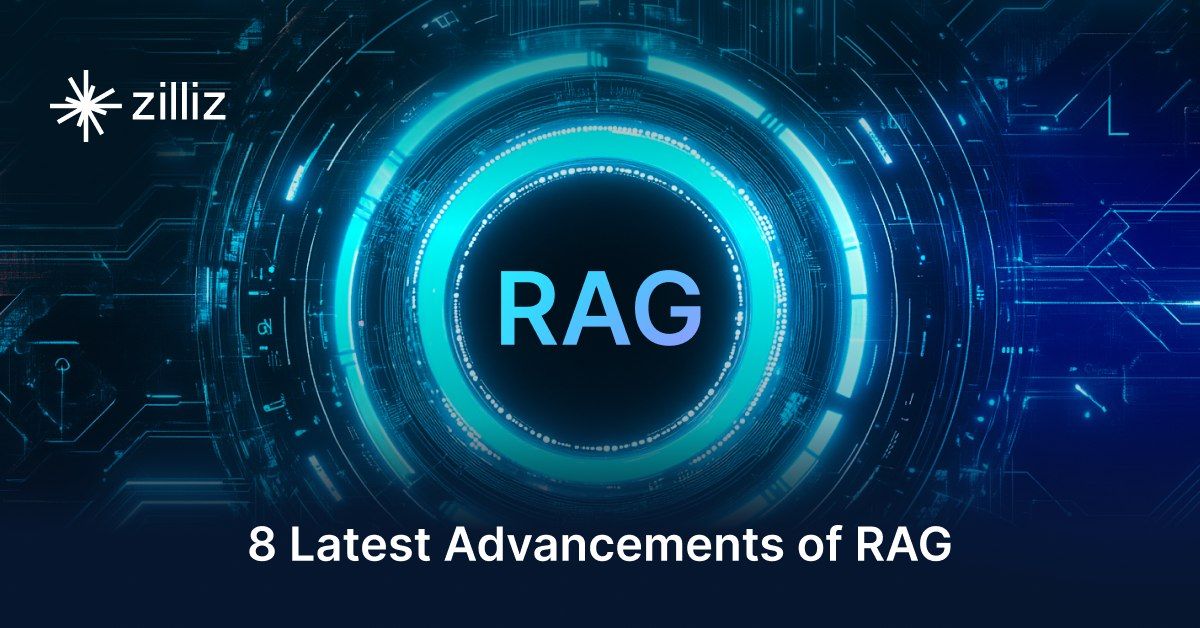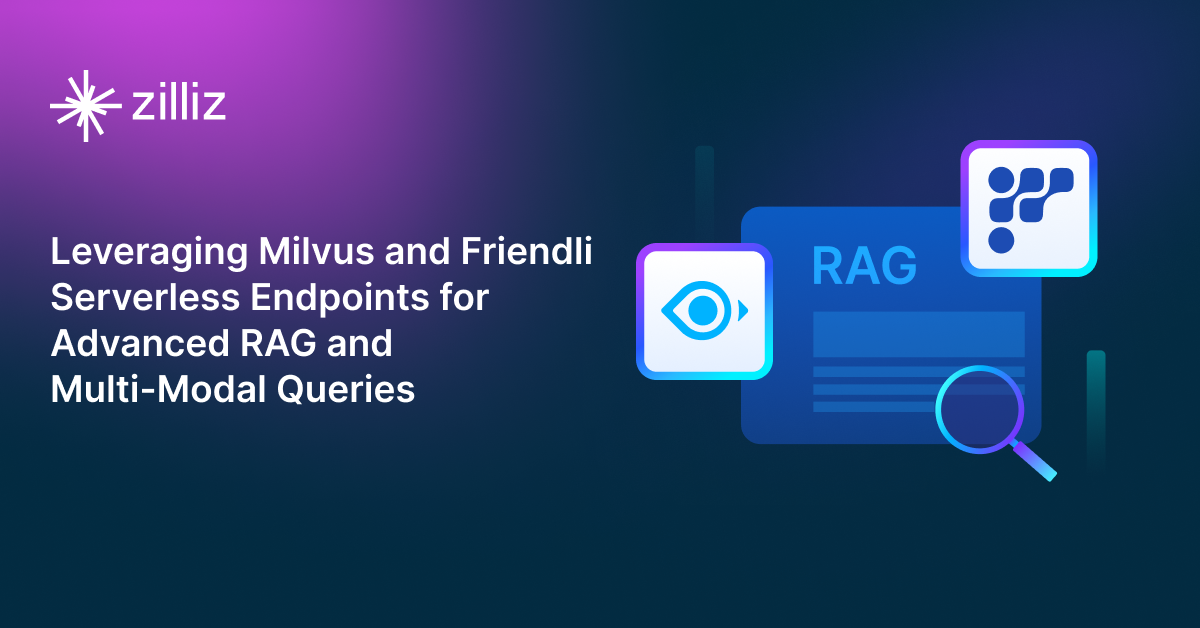Build RAG Chatbot with LangChain, Milvus, Cohere Command R+, and Google Vertex AI textembedding-gecko@001
Introduction to RAG
Retrieval-Augmented Generation (RAG) is a game-changer for GenAI applications, especially in conversational AI. It combines the power of pre-trained large language models (LLMs) like OpenAI’s GPT with external knowledge sources stored in vector databases such as Milvus and Zilliz Cloud, allowing for more accurate, contextually relevant, and up-to-date response generation. A RAG pipeline usually consists of four basic components: a vector database, an embedding model, an LLM, and a framework.
Key Components We'll Use for This RAG Chatbot
This tutorial shows you how to build a simple RAG chatbot in Python using the following components:
- LangChain: An open-source framework that helps you orchestrate the interaction between LLMs, vector stores, embedding models, etc, making it easier to integrate a RAG pipeline.
- Milvus: An open-source vector database optimized to store, index, and search large-scale vector embeddings efficiently, perfect for use cases like RAG, semantic search, and recommender systems. If you hate to manage your own infrastructure, we recommend using Zilliz Cloud, which is a fully managed vector database service built on Milvus and offers a free tier supporting up to 1 million vectors.
- Cohere Command R+: This model specializes in rapid retrieval and dense text understanding, prioritizing performance in search and information extraction tasks. With enhanced contextual awareness, it delivers accurate results, making it ideal for applications in customer support, content recommendation, and enterprise search solutions that demand high efficiency and relevance in responses.
- Google Vertex AI textembedding-gecko@001: This AI model specializes in generating high-quality text embeddings, facilitating superior semantic understanding and context capturing. Its strengths lie in efficient processing and scalability, making it ideal for applications like search, recommendation systems, and natural language understanding tasks that demand precise insights from textual data.
By the end of this tutorial, you’ll have a functional chatbot capable of answering questions based on a custom knowledge base.
Note: Since we may use proprietary models in our tutorials, make sure you have the required API key beforehand.
Step 1: Install and Set Up LangChain
%pip install --quiet --upgrade langchain-text-splitters langchain-community langgraph
Step 2: Install and Set Up Cohere Command R+
pip install -qU "langchain[cohere]"
import getpass
import os
if not os.environ.get("COHERE_API_KEY"):
os.environ["COHERE_API_KEY"] = getpass.getpass("Enter API key for Cohere: ")
from langchain.chat_models import init_chat_model
llm = init_chat_model("command-r-plus", model_provider="cohere")
Step 3: Install and Set Up Google Vertex AI textembedding-gecko@001
pip install -qU langchain-google-vertexai
from langchain_google_vertexai import VertexAIEmbeddings
embeddings = VertexAIEmbeddings(model="textembedding-gecko@001")
Step 4: Install and Set Up Milvus
pip install -qU langchain-milvus
from langchain_milvus import Milvus
vector_store = Milvus(embedding_function=embeddings)
Step 5: Build a RAG Chatbot
Now that you’ve set up all components, let’s start to build a simple chatbot. We’ll use the Milvus introduction doc as a private knowledge base. You can replace it with your own dataset to customize your RAG chatbot.
import bs4
from langchain import hub
from langchain_community.document_loaders import WebBaseLoader
from langchain_core.documents import Document
from langchain_text_splitters import RecursiveCharacterTextSplitter
from langgraph.graph import START, StateGraph
from typing_extensions import List, TypedDict
# Load and chunk contents of the blog
loader = WebBaseLoader(
web_paths=("https://milvus.io/docs/overview.md",),
bs_kwargs=dict(
parse_only=bs4.SoupStrainer(
class_=("doc-style doc-post-content")
)
),
)
docs = loader.load()
text_splitter = RecursiveCharacterTextSplitter(chunk_size=1000, chunk_overlap=200)
all_splits = text_splitter.split_documents(docs)
# Index chunks
_ = vector_store.add_documents(documents=all_splits)
# Define prompt for question-answering
prompt = hub.pull("rlm/rag-prompt")
# Define state for application
class State(TypedDict):
question: str
context: List[Document]
answer: str
# Define application steps
def retrieve(state: State):
retrieved_docs = vector_store.similarity_search(state["question"])
return {"context": retrieved_docs}
def generate(state: State):
docs_content = "\n\n".join(doc.page_content for doc in state["context"])
messages = prompt.invoke({"question": state["question"], "context": docs_content})
response = llm.invoke(messages)
return {"answer": response.content}
# Compile application and test
graph_builder = StateGraph(State).add_sequence([retrieve, generate])
graph_builder.add_edge(START, "retrieve")
graph = graph_builder.compile()
Test the Chatbot
Yeah! You've built your own chatbot. Let's ask the chatbot a question.
response = graph.invoke({"question": "What data types does Milvus support?"})
print(response["answer"])
Example Output
Milvus supports various data types including sparse vectors, binary vectors, JSON, and arrays. Additionally, it handles common numerical and character types, making it versatile for different data modeling needs. This allows users to manage unstructured or multi-modal data efficiently.
Optimization Tips
As you build your RAG system, optimization is key to ensuring peak performance and efficiency. While setting up the components is an essential first step, fine-tuning each one will help you create a solution that works even better and scales seamlessly. In this section, we’ll share some practical tips for optimizing all these components, giving you the edge to build smarter, faster, and more responsive RAG applications.
LangChain optimization tips
To optimize LangChain, focus on minimizing redundant operations in your workflow by structuring your chains and agents efficiently. Use caching to avoid repeated computations, speeding up your system, and experiment with modular design to ensure that components like models or databases can be easily swapped out. This will provide both flexibility and efficiency, allowing you to quickly scale your system without unnecessary delays or complications.
Milvus optimization tips
Milvus serves as a highly efficient vector database, critical for retrieval tasks in a RAG system. To optimize its performance, ensure that indexes are properly built to balance speed and accuracy; consider utilizing HNSW (Hierarchical Navigable Small World) for efficient nearest neighbor search where response time is crucial. Partitioning data based on usage patterns can enhance query performance and reduce load times, enabling better scalability. Regularly monitor and adjust cache settings based on query frequency to avoid latency during data retrieval. Employ batch processing for vector insertions, which can minimize database lock contention and enhance overall throughput. Additionally, fine-tune the model parameters by experimenting with the dimensionality of the vectors; higher dimensions can improve retrieval accuracy but may increase search time, necessitating a balance tailored to your specific use case and hardware infrastructure.
Cohere Command R+ optimization tips
Cohere Command R+ is an advanced model optimized for retrieval-heavy workloads, making it essential to refine context selection and ranking mechanisms. Use Cohere’s reranking models to sort retrieved passages based on semantic relevance, ensuring only the most pertinent information is processed. Optimize token economy by segmenting documents into meaningful chunks and limiting unnecessary context, preventing prompt overloading. Adjust retrieval depth dynamically based on query complexity—broader searches for complex queries and narrower ones for straightforward prompts. Fine-tune temperature and sampling parameters based on use cases, with lower values ensuring more reliable, factual outputs. For high-throughput applications, implement asynchronous processing and parallel query execution to improve efficiency. Caching and pre-generating responses for frequently accessed topics can significantly reduce inference costs and improve response time. Regularly test and refine retrieval configurations based on user feedback and performance analytics to maintain high-quality outputs in RAG workflows.
Google Vertex AI textembedding-gecko@001 optimization tips
Google Vertex AI textembedding-gecko@001 provides strong semantic understanding suitable for a variety of RAG workflows. To optimize retrieval, preprocess text to remove non-essential words and structure content to highlight key information. Use nearest neighbor search with techniques like HNSW or FAISS to enhance retrieval speed without sacrificing accuracy. Optimize batch processing by grouping multiple text queries together, reducing API call overhead and increasing throughput. Fine-tune temperature settings to ensure consistent responses, and adjust top-k or top-p parameters based on the desired level of output diversity. Cache embeddings for frequently used text and set up periodic updates to ensure embedding freshness. Use dimensionality reduction to manage memory usage and storage costs effectively.
By implementing these tips across your components, you'll be able to enhance the performance and functionality of your RAG system, ensuring it’s optimized for both speed and accuracy. Keep testing, iterating, and refining your setup to stay ahead in the ever-evolving world of AI development.
RAG Cost Calculator: A Free Tool to Calculate Your Cost in Seconds
Estimating the cost of a Retrieval-Augmented Generation (RAG) pipeline involves analyzing expenses across vector storage, compute resources, and API usage. Key cost drivers include vector database queries, embedding generation, and LLM inference.
RAG Cost Calculator is a free tool that quickly estimates the cost of building a RAG pipeline, including chunking, embedding, vector storage/search, and LLM generation. It also helps you identify cost-saving opportunities and achieve up to 10x cost reduction on vector databases with the serverless option.
 Calculate your RAG cost
Calculate your RAG cost
What Have You Learned?
What have you learned? Wow, what an incredible journey through the world of Retrieval-Augmented Generation (RAG) systems! You've just equipped yourself with a powerful toolkit by integrating LangChain, Milvus, Cohere Command R+, and Google Vertex AI's textembedding-gecko@001. Each of these components plays a unique and essential role, and together, they create synergy that can transform the way we interact with information.
Throughout the tutorial, you've seen how LangChain elegantly ties everything together, providing a flexible framework that orchestrates the flow of data and functionality. You discovered how Milvus serves up quick and efficient searches, enabling lightning-fast retrievals from a vast sea of data with unmatched speed and accuracy. It’s like having a supercharged librarian at your fingertips! But that's not all; the lifeblood of conversational intelligence came from leveraging the capabilities of Cohere Command R+, allowing your applications to understand and engage in meaningful dialogue. Add in the Google Vertex AI embedding model, which crafts rich, semantic representations, and you have a powerful system that's ready to tackle complex queries.
With cool features like optimization tips and a handy cost calculator to streamline your development process, you're fully equipped to dive in. Now, it's time to unleash your creativity and start building your own RAG applications! Challenge yourself to optimize and innovate, and remember—every great system starts with that first line of code. Let your enthusiasm guide you as you create solutions that could change the way people interact with knowledge. The future is bright—go ahead and explore!
Further Resources
🌟 In addition to this RAG tutorial, unleash your full potential with these incredible resources to level up your RAG skills.
- How to Build a Multimodal RAG | Documentation
- How to Enhance the Performance of Your RAG Pipeline
- Graph RAG with Milvus | Documentation
- How to Evaluate RAG Applications - Zilliz Learn
- Generative AI Resource Hub | Zilliz
We'd Love to Hear What You Think!
We’d love to hear your thoughts! 🌟 Leave your questions or comments below or join our vibrant Milvus Discord community to share your experiences, ask questions, or connect with thousands of AI enthusiasts. Your journey matters to us!
If you like this tutorial, show your support by giving our Milvus GitHub repo a star ⭐—it means the world to us and inspires us to keep creating! 💖
- Introduction to RAG
- Key Components We'll Use for This RAG Chatbot
- Step 1: Install and Set Up LangChain
- Step 2: Install and Set Up Cohere Command R+
- Step 3: Install and Set Up Google Vertex AI textembedding-gecko@001
- Step 4: Install and Set Up Milvus
- Step 5: Build a RAG Chatbot
- Optimization Tips
- RAG Cost Calculator: A Free Tool to Calculate Your Cost in Seconds
- What Have You Learned?
- Further Resources
- We'd Love to Hear What You Think!
Content
Vector Database at Scale
Zilliz Cloud is a fully-managed vector database built for scale, perfect for your RAG apps.
Try Zilliz Cloud for Free


